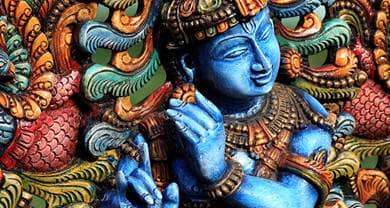- Trending:
- Pope Leo Xiv
- |
- Israel
- |
- Trump
- |
- Social Justice
- |
- Peace
- |
- Love

RELIGION LIBRARY
Hinduism
Community Organization
The Hindu world is a world of multiple and complex layers of social and communal categories and classification. There is the caste system, which lays out the four social and religious categories—Brahmin, Kshatriya, Vaishya, Shudra—into which people are placed according to their birth; there is the ashrama system, which articulates four different stages that a Hindu (male) is to pass through during the course of his life; there are sectarian affiliations, defined by the god or goddess one follows, and the rituals one performs in service to this deity.
| Four major sects of Hinduism |
|
It is important to recognize from the outset, however, that the internal divisions in these "systems" are not nearly so neat as they are often represented in the West. For example, there are thousands of different subcastes, which often have very subtle shadings and distinctions. One may identify oneself as a follower of Shiva, a Shaiva, but also worship forms of Vishnu and the goddesses.
 The caste system is one of the most contested issues in Hinduism and one of the most consistently misunderstood and misrepresented aspects of Hinduism. The origins of the caste system are disputed. Many have suggested that it is rooted in the Purusha Shukta hymn of the Rig Veda, the so-called "Sacrifice of the Primal Man," a text that describes creation in terms of a sacrifice of the first being. Four classes, or varnas, are described in this text. Out of this system seems to have developed the concept of jati, or birth, which is a more accurate description of caste: Hindus (and all humans) are born into particular socio-religious categories, castes (jatis), according to their accumulated karma. Over the centuries, the jatis have subdivided and multiplied, producing a complex network of thousands and thousands of different castes.
The caste system is one of the most contested issues in Hinduism and one of the most consistently misunderstood and misrepresented aspects of Hinduism. The origins of the caste system are disputed. Many have suggested that it is rooted in the Purusha Shukta hymn of the Rig Veda, the so-called "Sacrifice of the Primal Man," a text that describes creation in terms of a sacrifice of the first being. Four classes, or varnas, are described in this text. Out of this system seems to have developed the concept of jati, or birth, which is a more accurate description of caste: Hindus (and all humans) are born into particular socio-religious categories, castes (jatis), according to their accumulated karma. Over the centuries, the jatis have subdivided and multiplied, producing a complex network of thousands and thousands of different castes.
| Castes | |
| Brahmin | (priestly caste) |
| Kshatriya | (traditionally warrior caste) |
| Vaishya | (traditionally caste of merchants and farmers) |
| Shudra | (manual laborers) |
One of the most persistent, and some would say pernicious, aspects of the caste system are the strict rules regarding purity and pollution. The higher the caste, the more pure its members; and, conversely, the lower the caste, the more impure its members. Thus members of the lower castes—including the so-called untouchables, or outcastes—generally do not come into physical contact with members of the upper castes. Indeed, Hindus who belong to lower castes are often prevented from entering high caste temples—although this sort of discrimination is illegal in India and is much less common than it has been in the past—or participating in high caste rituals because their very presence is considered impure and polluting. Because the theological and philosophical principles underlying the caste system hold that one's caste is a matter of birth (jati), which is determined by one's actions in prior lives (karma), one is bound to that caste. Changing castes is thus impossible.
Some scholars, both inside and outside of India, have seen the development of the caste system not primarily as a religious but as a social mechanism, one used to control the population. More positively, castes have been seen as the products of self-organizing by communities. Caste-members can cooperate to pursue their self-interest. Although caste is still very much alive in contemporary India, not all Indians subscribe to this form of social organization.  Indeed, beginning at least as early as the 19th century, some Indians have argued that the caste system is not even part of Hinduism, citing the Upanishads and the Vedantic worldview as proof. In the 1950s (and earlier), following Mahatma Gandhi's famous rebellion against the socially repressive aspects of the caste system, there were attempts to abolish the caste system altogether, attempts that continue to this day. (It is important to note here that Gandhi was a caste Hindu and the preeminent Hindu leader of his day, and he was sharply criticized by Ambedkar and others who saw him as a defender of caste.) At any rate, caste at once remains a powerful means of social and religious organization in Hinduism, even as it is a matter of much dispute and tension.
Indeed, beginning at least as early as the 19th century, some Indians have argued that the caste system is not even part of Hinduism, citing the Upanishads and the Vedantic worldview as proof. In the 1950s (and earlier), following Mahatma Gandhi's famous rebellion against the socially repressive aspects of the caste system, there were attempts to abolish the caste system altogether, attempts that continue to this day. (It is important to note here that Gandhi was a caste Hindu and the preeminent Hindu leader of his day, and he was sharply criticized by Ambedkar and others who saw him as a defender of caste.) At any rate, caste at once remains a powerful means of social and religious organization in Hinduism, even as it is a matter of much dispute and tension.
 When the ideal of renunciation arose in Hinduism with the Upanishads and their rejection of Vedic sacrifice, some within the Hindu world perceived a potential social crisis. The Upanishads advocate abandonment of social life in favor of a life outside of society, spent in mediation. This idea of the proper religious path threatened to undo the very structure of life in Hinduism. A kind of compromise was articulated in the early years of the common era: the Ashrama system. A Hindu (typically, although not exclusively, a male) in this system was to pass through four stages: student (Brahmacarin or Brahmacari), householder (Grihastha), forest dweller (Vanaprastha), and renouncer (Sannyasin or Sannyasi). This was, in part, a way of removing the social disruption of renunciation; one could renounce, but only at the proper time.
When the ideal of renunciation arose in Hinduism with the Upanishads and their rejection of Vedic sacrifice, some within the Hindu world perceived a potential social crisis. The Upanishads advocate abandonment of social life in favor of a life outside of society, spent in mediation. This idea of the proper religious path threatened to undo the very structure of life in Hinduism. A kind of compromise was articulated in the early years of the common era: the Ashrama system. A Hindu (typically, although not exclusively, a male) in this system was to pass through four stages: student (Brahmacarin or Brahmacari), householder (Grihastha), forest dweller (Vanaprastha), and renouncer (Sannyasin or Sannyasi). This was, in part, a way of removing the social disruption of renunciation; one could renounce, but only at the proper time.
| THE FOUR ASHRAMAS | |
| Ashrama (station in life) | Duties |
| Student | Learn duties of his caste |
| Householder | Raise a family |
| Forest dweller | Study sacred texts |
| Renouncer | Meditate |
Hindu communities are organized in part by caste (as well as class, which is more of an economic than a religious categorization) and in part by sectarian affiliation. There are Vaishnava Hindus (followers of Vishnu), Shaiva Hindus (followers of Shiva), Shakta Hindus (followers of the goddesses), Smarta Hindus (non-theistic or pantheistic followers of Vedanta). But these are only the major sectarian divisions. In reality, there are thousands of what might be called sub-sects, whose members follower particular, often highly localized forms of the various gods and goddesses. Furthermore, although a Hindu might identify him or herself as a member of a particular sect—as a Vaishnava, say—that does not prevent him or her from worshipping other gods and goddesses who are not strictly associated with that sect.
Study Questions:
1. Why is it difficult to classify and categorize the Hindu world?
2. How did the caste system develop? How are individuals placed within it?
3. Is the caste system a divine creation? Why or why not?
4. How does the Ashrama system differ from the caste system?










